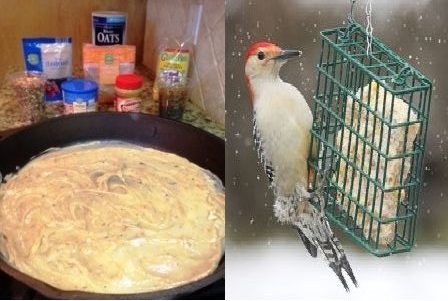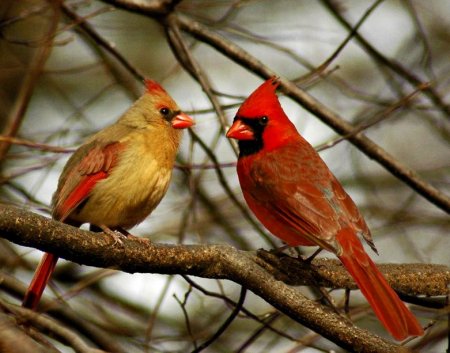 Don’t Forget About our Feathered Friends !
Don’t Forget About our Feathered Friends !
The Arctic Chill will arrive tonight and bringing with it freezing cold temperatures. So, what can we do to help our wild birds? We just need to provide them with things that may be scarce this time of year: shelter, water, and plenty of food.
WATER: BIRDBATH OR WATER GARDEN
Although water isn’t a limiting component of bird habitat in most of the Southeast, it may be scarce in some areas during periods of summer drought. Birds normally obtain the water they need from their food, temporary pools, dew on plants or the ground, or permanent water sources. If natural sources of water are not available in your yard or on a nearby property, a birdbath or artificial pond can provide an adequate water source and a focal area for watching birds.
• Birdbaths should be 2 to 3 inches deep and made of a rough surface to ensure good footing. The basin should be 2 to 3 feet in diameter with a lip or edge for perching.
• Moving water is attractive to birds, and inexpensive pumps can be placed in backyard ponds to provide the sound of running water that attracts birds and other wildlife.
STRUCTURE, COVER, AND SHELTER
Structure can mean a lot of things, but at its most basic, it means that plant structures, like trees, shrubs, or ornamental grasses, are used to support animal life. Structure provides birds places to hide from predators, to search for food or nesting material, to perch while looking for mates or prey, and to build nests or dens. There is, however, a need for structural diversity.
The larger the variety of plants you grow, the more kinds of birds your yard will attract.
Birds prefer a habitat layered with diversity. The alignment of trees in different heights and shapes, mid-level vegetation, such as shrubs, and structure close to the ground in the form of ground cover all fulfill slightly different purposes. Different birds eat and nest on the ground or in the shrub, mid-story, or canopy layers of your landscape.
Dense vegetation provides birds with places to escape from harsh weather and predators, such as hawks and house cats. Cover can become scarce during the winter, especially in areas dominated by deciduous plants.
Evergreen trees and shrubs, including native pines, American holly, yaupon, wax myrtle, and eastern red cedar provide a nighttime roosting habitat for birds and shelter from weather and predators in winter.
When choosing landscape plants for installation, select locally native plants appropriate for the lighting and soil conditions of your property. Plants native to the Piedmont region are more likely to thrive without pesticides or watering, plus they offer the foods best suited to our native birds.
YEAR-ROUND WILD FOODS
An assortment of plants will offer a variety of food in the form of flower buds, fruit, seeds, nectar, sap, and associated insects. Include a range of native plants that can provide many of the foods that birds need:
• Berry Plants – Include early- and late-fruiting plant species. Summer berries include blueberry; winter berries include holly.
• Seed Plants – Incorporate perennial wildflowers to seeds for birds in the fall and winter. Leave seed heads at the end of the growing season to provide an additional source of winter food for birds.
• Acorn Trees – Willow is a very popular oak known for its fall golden color and narrow leaves. Birds who love this plant include woodpeckers, jays and turkeys who depend on its acorns, and chickadees who need up to 9,000 caterpillars to raise one batch of babies.
BIRD FEEDERS TO SUPPLEMENT WILD FOODS
Bird feeders supplement the natural foods in your landscape and concentrate bird activity for easy viewing. Feeders are used most frequently during the winter, when natural foods are scarce. All feeders should be placed within 10-15 feet of shrubby vegetation, especially evergreen plants. This allows smaller birds to quickly escape from predators like hawks into nearby cover. Feeders should be cleaned every 2 to 3 weeks to prevent disease transmission.
Different birds are attracted by different kinds of seed, so offer a variety. Just make sure that the seed is compatible with both the feeder and the birds you hope to attract.
• Black oil sunflower seeds are the best all-around seed type for feeders. Cardinals, chickadees, grosbeaks, and buntings eat sunflower seeds.
• Safflower seeds will serve cardinals, grosbeaks, and house finches.
• Nyjer seeds lure finches and chickadees.
• Thistle seeds attract American goldfinches, house finches, pine siskins, and purple finches.
Now that you’ve picked the seed, it’s time to pick the right feeder!
Tray feeders are flat platforms that attract a variety of seed-eaters. Look for one with holes to allow rain or snow drainage.
Tube feeders are cylinders with mesh or plastic-coated wire screens. They’re great for small birds, such as finches, chickadees and nuthatches.
Hopper feeders have an enclosed reservoir for seeds that slides food down to the open feeding tray below. Plus, seed stays dry! Woodpeckers,grosbeaks and blue jays frequent these feeders.
Joe’s simple, inexpensive, and easy option: buy one tray feeder. Fill with a wild bird seed blend and add in about 20% black oil sunflower seeds. Bird seed goes on sale frequently at Southern States and Tractor Supply.
Other bird foods:
Dried mealworms are larvae of a flightless insect called the darkling beetle. They are an excellent source of protein, calcium, and vitamins for a great many birds, including some that normally don’t visit feeders.
Suet is beef fat and can safely be fed to birds. Animal fat is easily digested and metabolized by many birds; it’s a high-energy food, especially valuable in cold weather.
Suet is enjoyed by an incredible variety of birds, including bluebirds and jays, catbirds, kinglets, chickadees, nuthatches, pine warblers, woodpeckers, wrens, and some warblers. To make suet cakes at home, mix animal fat with corn meal, oatmeal, nuts/peanut butter, dried fruits, leftover birdseed, or even dried insects.
We’d like to share a recipe that is Marlis’ building block for homemade suet cakes. No special equipment is required. The ingredients are pantry staples. And, it’s a great hands-on activity for kids to get a little closer to nature. And, you may be asking about the animal fat. No, you do not need to go to the grocery store and purchase beef suet. Any leftover animal fat will serve as a binder and will be digested by the birds.

large pan of animal fat (rendered)
1 jar peanut butter
grains (uncooked oats, uncooked corn grits, cooked rice)
bird food, whole sunflower seeds, dried mealworms – 2 to 3 cups total
nuts (sunflower kernels, chopped nuts)
dried fruit (any kind of berries)
masa (add until the mixture is the consistency of cookie dough)
Melt the fat in an oversized cast iron skillet (or heatproof vessel) on the stove top. Swirl in the peanut butter until emulsified. Turn off heat. Add in all other ingredients.
Line a 13 x 9 inch casserole dish with wax paper on the bottom and sides. Pour in the suet cake mixture – it will fill the dish to a 1 inch depth; let set up at room temp; refrigerate. Slice and divide into 6 square cakes. It may be prudent to keep refrigerated or frozen until ready to use. Homemade suet cakes are best suited to be utilized during the winter months to avoid melting.
ABOUT US
Joe Morrison owns and operate Morrison Lawn and Landscape. We provide full service lawn care to both residential and commercial customers in select areas of Gastonia, NC. If you have interest for us to visit your property for a free consultation for weekly lawn care, contact us today at (704) 813-2545. Click here to contact us via email.

